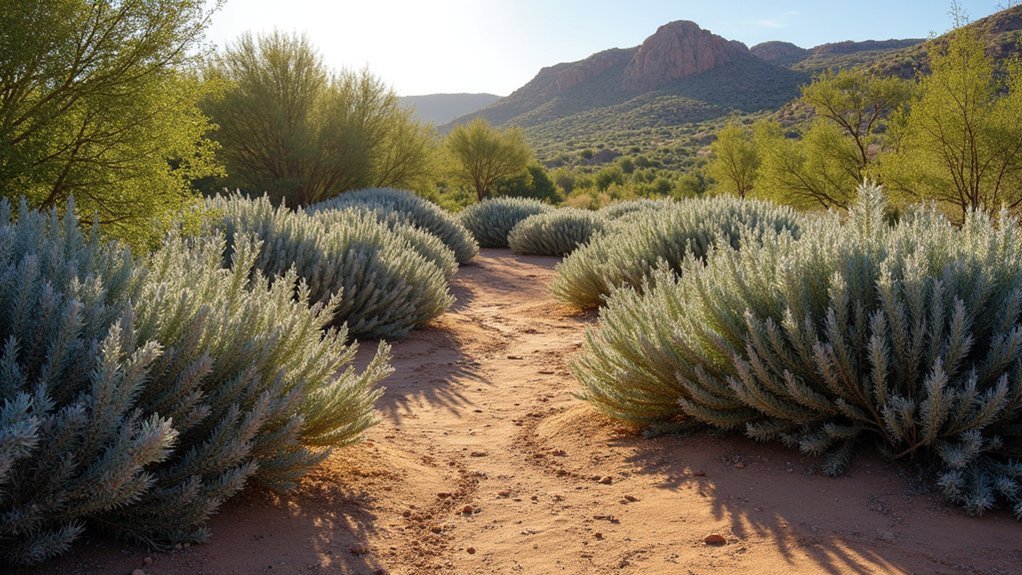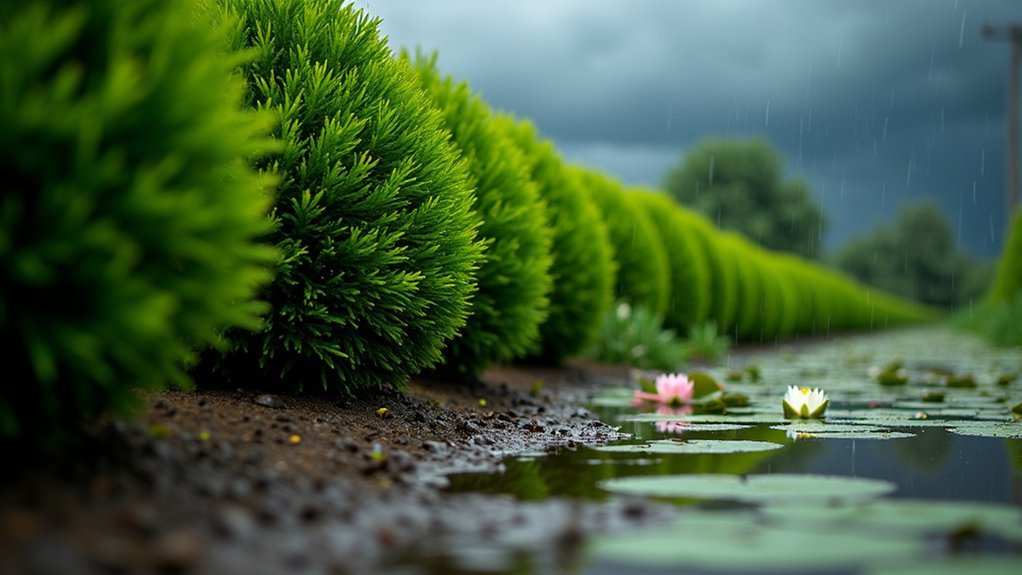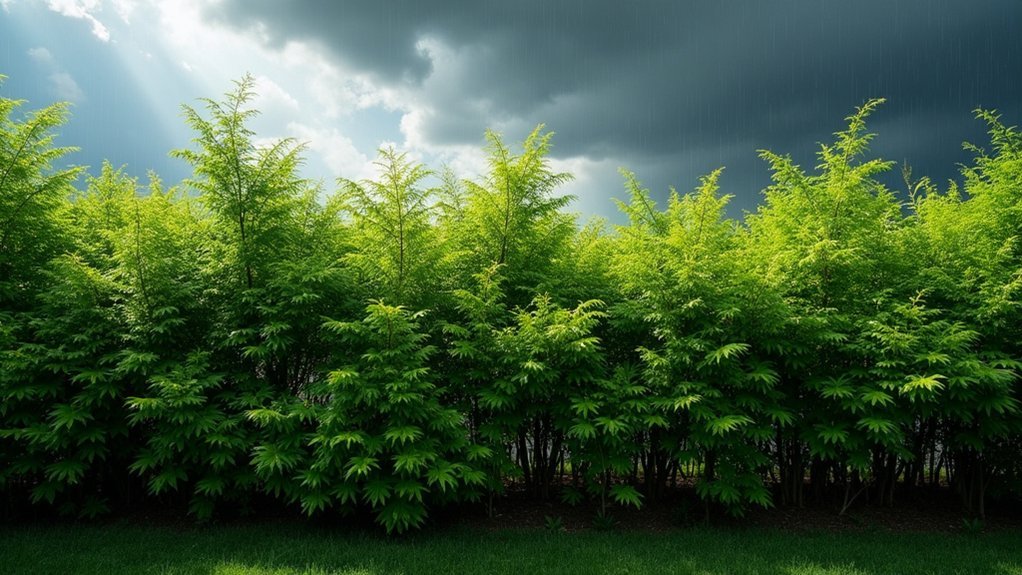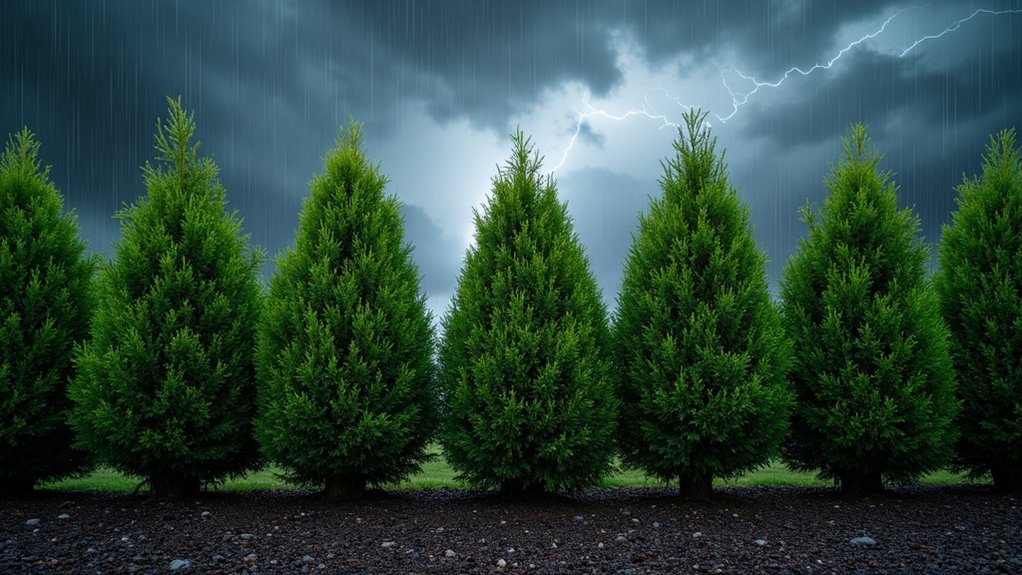Weather-resilient hedges like Boxwood ‘Green Mountain’, Cherry Laurels, and Southern Wax Myrtle create living fortresses against extreme conditions. These plants offer year-round privacy while withstanding storms, drought, freezing temperatures, and flooding. For coastal areas, try Walter’s Viburnum or Japanese Blueberry, while Arizona Cypress excels in desert regions. You’ll need proper spacing and consistent watering during establishment. The right selection transforms your vulnerable perimeter into an impenetrable, beautiful barrier for years to come.
The Climate Fortress: Why Weather-Resilient Hedges Matter

While traditional landscaping may wither under nature’s wrath, weather-resilient hedges stand as living fortresses against extreme conditions.
You’ll find these botanical guardians offer year-round privacy while standing firm against whatever Mother Nature throws their way.
Privacy hedges like boxwood and cherry laurels create dense barriers that maintain their appeal through storms, snow, and scorching heat.
Selecting Cold-Hardy Hedge Varieties for Freeze Protection
When winter releases its full fury, only the toughest hedge varieties remain standing as green sentinels in your landscape. To maintain your privacy screen year-round, choose cold-hardy hedge varieties that withstand freezing temperatures while preserving their aesthetic appeal.
- Boxwood ‘Green Mountain’ (zones 5-9) offers exceptional freeze tolerance while maintaining its rich green color throughout winter.
- Cherry Laurels, including English and Schip varieties, provide dense growth with shiny leaves that create effective privacy barriers despite harsh conditions.
- Hicks Yew thrives in zones 5-8, featuring dark green foliage that adapts to various garden settings.
These evergreen shrubs not only enhance your landscape’s appearance but guarantee your privacy screen remains intact regardless of severe winter weather.
Drought-Resistant Champions: Hedges That Thrive in Dry Conditions

As summer heat waves intensify and rainfall becomes increasingly unpredictable, drought-resistant hedges offer a practical solution for maintaining privacy without excessive water consumption.
Arizona Cypress and Yaupon Holly stand out as exceptional choices, providing dense evergreen foliage that thrives in arid conditions while creating effective privacy screens.
Once established, Elaeagnus requires minimal watering yet delivers impressive screening capabilities in dry landscapes.
For taller privacy needs, Southern Wax Myrtle grows up to 15 feet and adapts to various soil types while withstanding prolonged dry spells.
Both evergreen and flame-leaf sumac varieties offer low-maintenance options that conserve water without sacrificing visual appeal.
Consider Walter’s Viburnum for a pest-resistant, drought-tolerant hedge that combines resilience with beauty—ideal for creating long-lasting privacy barriers in regions where water conservation is essential.
Wind Warriors: Barrier Plants That Stand Strong Against Storms
Your storm defense strategy starts with understanding how specialized leaf structures and flexible branches allow wind warriors like Southern Wax Myrtle and Japanese Blueberry to absorb gusting forces without breaking.
You’ll find regional champions suited to your specific climate challenges, from the narrow Yaupon Holly ‘Scarlet’s Peak’ for tight spaces to the virtually pest-free Walter’s Viburnum for exposed coastal areas.
These strategic plantings create effective windbreaks while contributing to your landscape’s biodiversity and aesthetic appeal.
Wind-Resistant Plant Anatomy
Three key structural elements make certain plants natural wind warriors in your landscape. When creating hedges that can withstand severe weather, look for species with flexible stems that bend rather than break, deep root systems that anchor firmly, and dense but permeable foliage with glossy dark green leaves that reduce wind resistance.
- Flexible woody stems allow plants to sway and bend during high winds without snapping.
- Extensive root networks provide vital stability and access to water during drought conditions.
- Compact growth habits with strong branch attachments resist breakage under pressure.
- Smaller, thicker leaves with waxy coatings better withstand wind desiccation than large, thin foliage.
Understanding these anatomical features helps you select wind-resistant plants that will maintain their structural integrity while protecting your property from damaging gusts.
Regional Wind Champions
Selecting the right wind-resistant plants for your specific climate zone dramatically increases their survival rate during extreme weather events.
In coastal regions, Southern Wax Myrtle and Elaeagnus excel as wind-resistant shrubs, creating effective windbreaks with their flexible branches and dense foliage.
For taller privacy screen needs, the Japanese Blueberry stands out, reaching 40-60 feet with glossy leaves that withstand powerful gusts.
In more variable conditions, consider Yaupon Holly ‘Scarlet’s Peak,’ a native option growing to 20 feet that maintains vertical integrity during severe storms.
Walter’s Viburnum offers pest-resistant density perfect for wind barriers.
For drier climates, incorporate drought-tolerant species like Arizona Cypress and Junipers, which provide dual benefits of storm protection and water conservation in vulnerable landscaping areas.
Flood-Tolerant Hedge Options for Wet-Prone Areas

While many plants struggle in waterlogged conditions, certain hedge varieties thrive in consistently wet soil, making them ideal solutions for flood-prone landscapes.
Nature’s answer to wet challenges: resilient hedges transform flood-prone areas into thriving green boundaries.
When selecting flood-tolerant shrubs for your wet-prone property, consider options that won’t succumb to root rot in saturated conditions.
- Southern Wax Myrtle grows up to 15 feet tall and adapts excellently to wet soils
- Viburnum, especially Walter’s Viburnum, provides dense screening foliage in flood-prone areas
- Elaeagnus withstands temporary flooding while offering distinctive silver-white foliage for visual contrast
- Yaupon Holly ‘Scarlet’s Peak’ reaches 20 feet tall in wet conditions and produces wildlife-attracting red berries
Remember to space your flood-tolerant hedges adequately to promote air circulation, which helps reduce disease risk from prolonged moisture exposure.
Multi-Season Performance: Hedges That Maintain Structure Year-Round
Homeowners who face seasonal extremes need hedges that perform reliably throughout the year, not just during ideal growing conditions.
Boxwood varieties like Green Mountain excel in this regard, offering freeze tolerance in zones 5-8 while maintaining their structured appearance regardless of temperature fluctuations.
Cherry Laurel (Prunus) delivers year-round privacy with its shiny, resilient foliage that withstands harsh winters in zones 6-9.
You’ll appreciate its lush appearance even during the most challenging seasons.
For medium to tall privacy solutions, consider Hicks Yew, which combines cold hardiness with attractive dark green foliage and red berries.
When selecting for multi-season performance, prioritize shrubs with dense growth patterns like viburnum and privet—they’ll retain their structural integrity through extreme weather events while providing consistent visual appeal.
Native Selections: Region-Specific Hedges for Maximum Resilience

Your coastal landscape needs protection that can withstand salt spray, high winds, and occasional flooding, making native shrubs like Southern Wax Myrtle ideal defenders against harsh maritime conditions.
In desert regions, you’ll want hardy barrier champions such as Yaupon Holly ‘Scarlet’s Peak’ that thrive despite intense heat and minimal rainfall while still providing effective screening.
These region-specific native selections offer superior resilience because they’ve evolved alongside local extreme weather patterns, ensuring your hedge investment stands strong when conventional options might fail.
Coastal Defense Stalwarts
Along coastal regions where salt spray, persistent winds, and sandy soils challenge even the hardiest plants, native selections offer unmatched resilience against extreme weather conditions.
Southern Wax Myrtle stands out as a resilient choice that thrives in coastal conditions while providing dense screening against storm winds.
For your seaside property, consider these exceptional performers:
- Walter’s Viburnum grows to 12 feet tall with virtually no pest issues, creating impenetrable barriers
- Elaeagnus tolerates drought and sandy soils while requiring minimal maintenance
- Japanese Blueberry trees reach impressive 40-60 foot heights, forming substantial windbreaks
- Viburnum Awabuki delivers both fragrant blooms and sturdy protection
You’ll find these coastal warriors not only survive but flourish where other plants fail, protecting your property while enhancing its natural beauty.
Desert-Adapted Barrier Champions
While coastal regions battle salt spray and persistent winds, desert landscapes present an entirely different set of challenges for hedge survival. Your desert-adapted hedges must withstand scorching heat, minimal rainfall, and temperature extremes.
| Plant Option | Height | Key Features |
|---|---|---|
| Arizona Cypress | 40-60 ft | Exceptional drought tolerance, freeze-resistant |
| Walter’s Viburnum | 8-25 ft | Dense screening, pest-free, low maintenance |
| Japanese Blueberry | Up to 60 ft | Adapts to poor soil, extreme heat-tolerant |
Native selections like Southern Wax Myrtle and Elaeagnus offer remarkable resilience with minimal care. When selecting your desert champions, prioritize species that demonstrate both drought tolerance and temperature resilience. Yaupon Holly thrives in arid conditions while providing dense coverage, making it perfect for creating privacy barriers that won’t surrender to harsh desert conditions.
Proper Planting Techniques for Weather-Hardened Hedges
Three critical factors determine whether your weather-resistant hedge will thrive or merely survive: proper hole dimensions, soil preparation, and spacing.
When implementing proper planting techniques, dig holes twice as wide as the root ball but equal to its depth. This encourages roots to expand outward rather than downward, creating a stable foundation against extreme weather.
- Mix organic matter into your soil before planting to improve drainage and nutrient content
- Water deeply and consistently during the first year to establish robust root systems
- Space plants according to mature width to promote healthy airflow between specimens
- Apply a 2-3 inch layer of mulch around each plant, keeping it away from stems to prevent rot
Long-Term Maintenance Strategies for Extreme Condition Hedges

Once established, weather-resistant hedges require vigilant maintenance to thrive despite nature’s challenges. Your vigilance during extreme weather events will determine their longevity. Monitor conditions regularly and adjust your watering schedule accordingly during droughts or excessive rainfall.
| Maintenance Strategy | Emotional Benefit |
|---|---|
| Apply seasonal mulch | Peace of mind during temperature fluctuations |
| Prune after storms | Pride in hedge recovery and resilience |
| Implement tailored fertilization | Joy watching robust growth despite challenges |
| Select cold-hardy varieties | Confidence during harsh winter conditions |
| Monitor weather patterns | Relief knowing you’re prepared for extremes |
Remember to fertilize according to your specific hedge variety’s needs, strengthening root systems that withstand harsh conditions. For long-term success, cold-hardy varieties like Boxwood and Cherry Laurel offer exceptional resilience when properly maintained. Remove damaged branches promptly to improve air circulation and prevent disease spread through your living fortress.
Frequently Asked Questions
What Is the Most Hardy Hedge?
You’ll find Boxwood, Cherry Laurel, and Hicks Yew among the most hardy hedges. They thrive in zones 5-9, withstand harsh conditions, and maintain their dense foliage year-round for reliable privacy.
What Is the Best Hedge Plant for All Year Round?
Boxwood is your best all-year-round hedge option. You’ll appreciate its dense evergreen foliage that provides consistent privacy and windbreak benefits regardless of season, while thriving across USDA hardiness Zones 5-9.
What Is the Best Plant to Block Neighbors’ Views?
For blocking neighbors’ views, you’ll want privet or arborvitae for quick privacy. Cherry laurel offers year-round screening, while dense Viburnum creates an impenetrable barrier. Plant them closer together for faster coverage and maximum privacy.
What Plants Are Good for High Hedges?
For high hedges, you’ll find Yaupon Holly ‘Scarlet’s Peak’ excellent for vertical privacy, Japanese Blueberry impressive at 40-60 feet, Arizona Cypress drought-tolerant at 20-30 feet, Walter’s Viburnum dense at 12 feet, and Photinia reaching 15 feet.
In Summary
You’ve now got the knowledge to build your green fortress against nature’s extremes. By selecting hedges suited to your region’s challenges—whether cold, drought, wind, or flooding—and following proper planting and maintenance techniques, you’ll create a resilient living barrier that protects your property while enhancing its beauty for years to come. Your weather-proof hedge is an investment in landscape security.





Leave a Reply